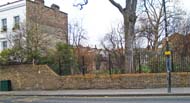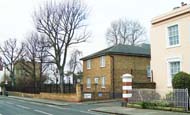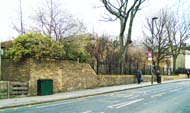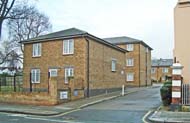Specialist
In 1916 a Royal Commission on venereal disease (VD) expressed concern on its effects on the individual and the community. One of the commonest causes of blindness was ophthalmia neonatorum, a form of conjunctivitis, usually contracted by the baby during the birth process from its mother infected with gonorrhoea. Ophthalmia neonatorum had become a notifiable disease in 1914, not to prevent the spread of the disease but to ensure that the infant received prompt treatment. Untreated infants faced the possibility of blindness due to corneal ulceration.
Under the impetus of The Report of the Departmental Committee on the Welfare of the Blind, issued in 1917, the Local Government Board asked the Metropolitan Asylums Board (MAB) to provide hospital treatment for babies with the condition.
In September 1917 MAB bought the former St Margaret's Children's Receiving Home in Leighton Road from the St Pancras Union.
St Margaret's Hospital, on a one acre site, opened in 1918 and could accommodate 20 mothers and 30 infants. An ophthalmic surgeon and a gynaecologist were appointed to the staff.
Prevention of blindness depended much on treatment being instituted as soon after birth as possible. Treatment consisted of the eyelids being swabbed regularly, followed by a drop of 2% silver nitrate into each eye. But in 1919 infants were still being admitted at a late stage of the disease, with corneal ulceration, even though an ambulance service was provided by MAB to ferry parturient mothers and babies to St Margaret's.
By 1921 the accommodation for patients and staff was improved and the Hospital could accommodate 48 mothers.
In 1923 225 babies were treated, of whom 13 died - a death rate of 5.7% - but premature birth would have been primarily responsible for these deaths. (In 1922 the death rate had been 15%).
The Hospital was legitimately proud that no baby was left completely blind, but it proved difficult to persuade the mothers to have treatment for gonorrhoea. Successful treatment depended on the length of stay, but the mothers were discharged once their infant's eyes had cleared up, and they were referred to the VD clinic in their nearest general hospital.
In 1924 a clinic was set up for the aftercare of children, especially those from other children's and TB institutions, for example, those with ear disease treated at Downs Hospital.
By 1929 about 150 mothers and 250 babies were being admitted each year, about a third of all notified cases of ophthalmia neonatorum in London. By this time the Hospital had 60 beds, 18 of which were for children with marasmus or zymotic enteritis (summer diarrhoea).
In 1930 the Hospital came under the administrative control of the LCC.
Present status (December 2008)
There is nothing left of the Hospital except perhaps an original wall. Half the site now contains a small housing estate and the other half is given over to open space.
Maybe part of the original wall along Leighton Road.

Looking along Leighton Road from the east.

Looking along Leighton Road from the west.

The view into the current housing estate.
In 1920 MAB also bought a property on a 17-and-a-half acre site - The Cedars in Blackheath - for use as a 50-bedded hospital for venereal disease, but this does not appear to have been used.
The term 'venereal disease' has now been generally replaced by 'sexually transmitted infections' (STIs).
(Author unstated) 1918 Hospital for ophthalmia neonatorum. British Journal of Ophthalmogy 2, 574.
(Author unstated) 1919 The early treatment of ophthalmia neonatorum. British Journal of Ophthalmogy 3, 365.
http://rcnarchive.rcn.org.uk
www.workhouses.org.uk
Return to home page